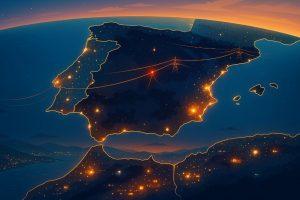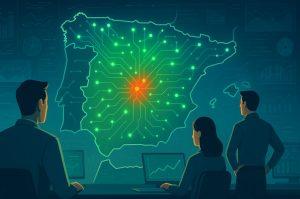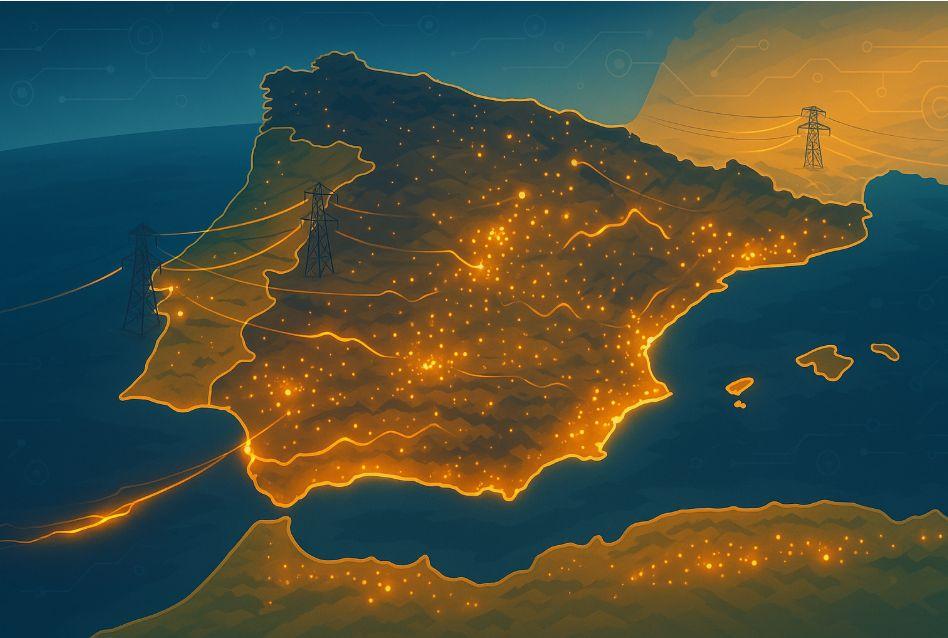In an era where energy security is paramount, the recent power failure across Spain and Portugal has raised pressing concerns across Europe. The incident, which left millions without electricity for several hours, has prompted a detailed investigation into the root causes and systemic failures that allowed a localised fault to escalate into a regional crisis.
The Spain Portugal blackout report, published by national energy agencies in collaboration with ENTSO-E, offers critical insight into the vulnerabilities of interconnected power grids. For policymakers, energy professionals, and citizens alike, this event serves as a stark reminder of the delicate balance that sustains our modern energy infrastructure.
What Happened During the Spain-Portugal Blackout Incident?

In mid-2025, millions across Spain and Portugal faced a sudden power outage that disrupted nearly every facet of daily life. This unexpected blackout originated in northern Portugal and spread rapidly into central and southern Spain, affecting major cities like Porto, Lisbon, Madrid, and Seville. The disruption lasted anywhere from a few minutes in some urban centres to several hours in remote regions.
The Spain Portugal blackout report, jointly released by national energy authorities and ENTSO-E (European Network of Transmission System Operators for Electricity), offers a comprehensive breakdown of the incident.
It reveals how a high-voltage transmission line failure triggered a domino effect, pushing the Iberian power grid into imbalance and overwhelming its ability to self-correct.
As lights went out and systems failed, emergency services were deployed, while citizens scrambled to adapt. The blackout was not just a technical failure but a regional crisis that revealed critical shortcomings in energy infrastructure and inter-country coordination.
What Were the Causes Behind the Power Failure in the Iberian Peninsula?
According to the blackout report, the crisis began with a technical fault in a key transmission line in northern Portugal. The system, already under strain from high summer electricity demand, was unable to reroute the load efficiently. Within minutes, the disruption cascaded across the shared energy grid with Spain, highlighting the vulnerabilities of interconnected systems.
An important detail from the report is the failure of early detection systems. Operators reportedly missed a critical three-minute window during which preventive action could have minimised the outage.
Moreover, some substations lacked automatic backup capabilities, making them unable to adapt in real time. While the possibility of a cyberattack was investigated, the findings confirmed that the event stemmed purely from mechanical and procedural breakdowns.
This blackout illustrates how a single point of failure, if left unchecked, can escalate across borders and impact millions, especially in regions with highly integrated energy networks.
How Vulnerable Is the Cross-Border Energy Grid Between Spain and Portugal?
The Spain Portugal blackout report casts a spotlight on the risks posed by shared energy infrastructure. The Iberian Peninsula operates as a single energy market in many respects, with Spain and Portugal relying on a coordinated grid that supports mutual electricity exchange.
This system works well during normal conditions. However, the blackout revealed how interconnectivity without isolation protocols can amplify problems. When the transmission failure occurred, Spain’s energy system could not shield itself from Portugal’s grid imbalance, leading to widespread outages on both sides.
The report calls for the urgent development of decoupling mechanisms systems that allow one country to disconnect temporarily during emergencies to prevent further impact. Additionally, outdated components and underinvestment in monitoring infrastructure contributed to the rapid spread of the failure.
As European countries continue to integrate their grids to support renewable energy targets, the Iberian case serves as a cautionary tale: resilience must match integration.
What Key Insights Does the Spain Portugal Blackout Report Offer?

The blackout report outlines several areas of concern that extend beyond technical faults. It reveals systemic issues such as delays in emergency coordination between the Spanish and Portuguese Transmission System Operators (TSOs), reliance on outdated control room software, and gaps in crisis communication protocols.
Perhaps most concerning is the over-reliance on renewable energy sources like solar and wind, which, while sustainable, are vulnerable to sudden weather changes. During the blackout, a brief drop in solar generation due to overcast skies may have compounded the existing transmission issue, worsening the grid instability.
The report recommends modernising transmission lines, improving grid segmentation technology, and creating shared command centres between the two countries. The findings are clear: even in developed countries, energy resilience cannot be taken for granted.
How Did the Blackout Affect Daily Life and Economic Activities?
The blackout’s impact extended far beyond flickering lights and quiet streets. In urban centres like Madrid and Lisbon, public transport systems ground to a halt.
Trains, underground metros, and tram lines stopped mid-service, causing delays and confusion. Emergency services responded swiftly, but hospitals particularly in rural areas struggled to maintain essential services despite having backup generators.
For many businesses, especially small enterprises, the power cut translated into lost revenue. Retailers could not process card transactions, data centres faced service interruptions, and manufacturers saw production lines stall. In sectors already weakened by inflation and post-pandemic recovery, the disruption was particularly damaging.
Telecommunication networks were not spared. Mobile services were disrupted in several regions, while internet connectivity dropped significantly, limiting communication during critical moments. Overall, the economic cost is estimated to exceed €1.2 billion, with wider implications for investor confidence in the region’s infrastructure.
What Measures Are Being Proposed to Prevent Future Power Failures?
Both Spain and Portugal have acknowledged the severity of the event and announced sweeping reforms aimed at preventing future incidents. Among the proposed solutions is the modernisation of energy infrastructure, including the deployment of smart grid systems capable of real-time monitoring and self-correction.
Additionally, the creation of regional “island” zones within the grid has been recommended. These zones would allow parts of the system to operate independently during emergencies, thereby preventing widespread failures.
Improved cooperation between TSOs in both countries is also on the agenda, with plans for joint training, shared control systems, and emergency response simulations.
At the European level, the blackout has prompted policymakers to revisit funding priorities under the EU’s Green Deal energy transition plans. There is growing consensus that energy resilience should be a core pillar of sustainability, not a secondary concern.
How Does This Blackout Compare to Other Major Energy Failures in Europe?

While blackouts are not uncommon in Europe, the 2025 Spain-Portugal outage stands out for its rapid onset and scale. Unlike the 2006 European blackout, which affected more countries but was swiftly contained, or the UK’s 2019 incident, which was limited to specific regions, this event exposed the risks of tightly bound regional grids operating without sufficient safeguards.
The report makes clear that the Iberian blackout was not caused by extraordinary circumstances but by predictable failures in system design, coordination, and maintenance. This distinguishes it from incidents driven by natural disasters or sabotage.
When placed in context, the event underscores the importance of embedding resilience into the very fabric of Europe’s evolving energy infrastructure, especially as climate variability and renewable energy integration continue to reshape the grid.
What Is the Broader Message for Europe’s Energy Future?
The spain portugal blackout report does more than explain a single event. it reflects the broader challenges facing Europe’s energy transition. As nations increasingly adopt decentralised and renewable power systems, the complexity of maintaining grid stability grows.
The Iberian blackout signals that investment in infrastructure must go hand-in-hand with innovation in system management and emergency preparedness.
Energy experts argue that resilience should no longer be treated as an afterthought. As the EU pushes for decarbonisation and digital transformation, equal attention must be paid to grid flexibility, inter-country coordination, and cybersecurity.
The blackout has also sparked public debate across Europe about how prepared we really are for energy emergencies. It serves as a reminder that while sustainability is a noble goal, it must be built on a foundation of reliability and safety.
Timeline of Events During the Spain-Portugal Blackout
| Date & Time (2025) | Event Description | Affected Area | Response Authority |
| 14 Sept, 10:17 AM | Voltage anomaly detected in northern Portugal | Porto, Braga | REN Portugal |
| 14 Sept, 10:21 AM | Fault spreads to western Spain | Galicia, Salamanca | Red Eléctrica de España |
| 14 Sept, 10:29 AM | Blackout hits Madrid and Lisbon | Madrid, Lisbon | Regional Emergency Teams |
| 14 Sept, 11:12 AM | Partial restoration begins | Central and North Iberia | ENTSO-E & TSOs |
| 14 Sept, 3:45 PM | Full power restored in major cities | Nationwide | Joint Ops |
Conclusion
The Spain Portugal blackout report presents more than just a post-mortem of a technical failure. it offers a roadmap for future preparedness and resilience. As Europe moves toward greater grid integration and renewable energy adoption, the risks associated with complex, interdependent systems will only grow.
This incident underscores the urgency of upgrading outdated infrastructure, enhancing real-time monitoring capabilities, and strengthening cross-border coordination. For the UK and the rest of Europe, the Iberian blackout is a clear signal: energy resilience must become a central pillar in planning for a sustainable and secure future.
FAQs
What caused the Spain-Portugal blackout in 2025?
The blackout was triggered by a failure in a key transmission line in northern Portugal, combined with delayed emergency responses and system vulnerabilities across the shared Iberian energy grid.
How long did the blackout last in Spain and Portugal?
Power outages lasted from several minutes to several hours depending on the region, with major cities like Madrid and Lisbon regaining electricity faster than rural zones.
Did the blackout affect communication and emergency services?
Yes. Telecommunication networks were disrupted, and some hospitals experienced temporary outages despite backup systems. Emergency services were strained but remained operational.
Was there any foreign interference or cyberattack involved?
No evidence suggests foreign interference or a cyberattack. The investigation pointed to internal technical faults and coordination lapses.
What are Spain and Portugal doing to prevent this again?
Both countries are planning major infrastructure upgrades, including smart grid technologies, regional isolation capabilities, and better cross-border coordination.
How is the European Union responding to this event?
The EU is reviewing its energy infrastructure resilience strategy and considering increased funding for decentralisation and real-time monitoring technologies.
Is the UK susceptible to a similar blackout?
While the UK has a more isolated grid, experts warn that without investment in smart infrastructure and cybersecurity, it too could face future disruptions.









Leave feedback about this